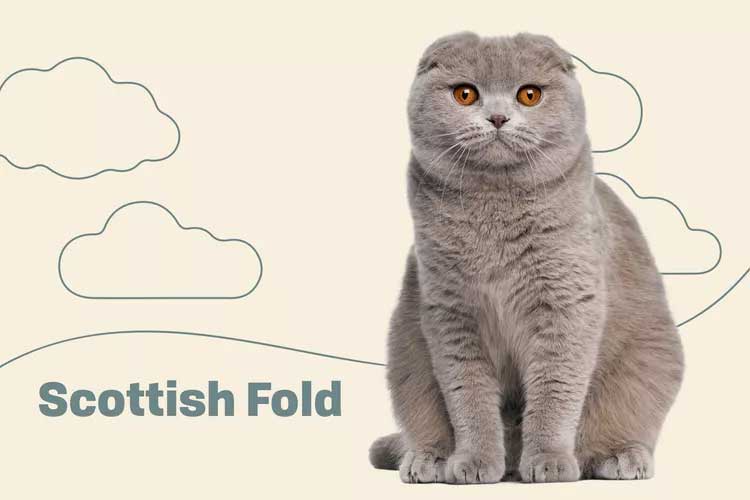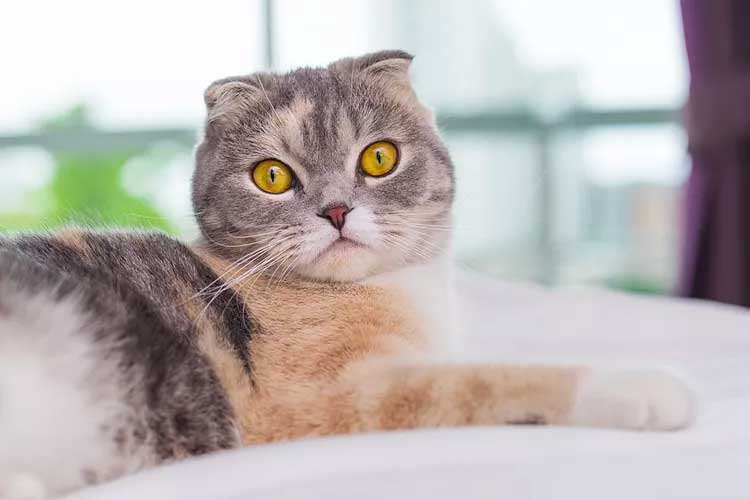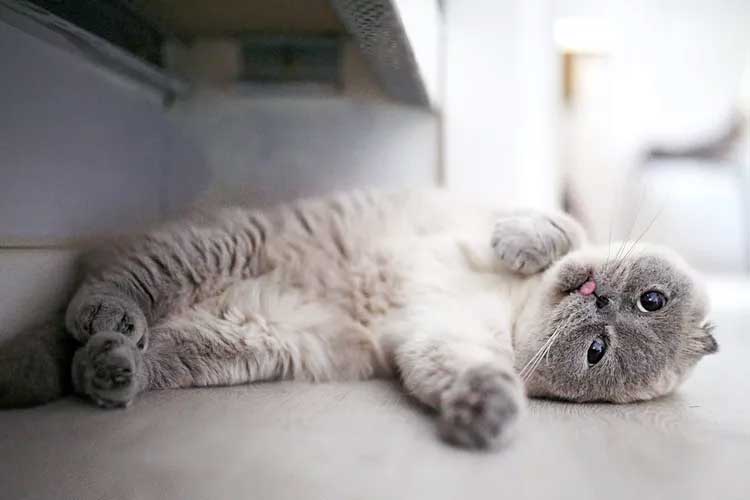Scottish fold cats make great, affectionate pets that thrive on human interaction without being too demanding for your constant attention. They have a charmingly unique appearance due to their ear carriage, round heads and eyes, and thick legs and tail.

Scottish Fold (Highland Fold) Overview
| OFFICIAL NAME | Scottish Fold (Highland Fold) |
| COMMON NAME | Scottish Fold (Highland Fold) |
| PET HEIGHT | 8 to 10 inches |
| PET WEIGHT | 6 to 13 pounds |
| LIFESPAN | 11 to 14 years |
| GOOD WITH | cats, children, dogs, families, seniors |
| TEMPERAMENT | affectionate |
| INTELLIGENCE | high |
| SHEDDING AMOUNT | normal |
| PLAYFULNESS | medium |
| ENERGY LEVEL | calm |
| VOCAL LEVEL | when necessary |
| COAT LENGTH | long, short |
| COLORS | black / ebony, blue / gray, cream / beige / tan, fawn, lavender / silver, red / orange |
| OTHER TRAITS | easy to groom, easy to train, friendly toward humans, friendly toward other pets, friendly toward strangers, good lap cat, high potential for weight gain, tolerates being alone, tolerates being picked up |
Scottish folds are rare felines, prized for their huggable good looks and sweet personalities. Sporting round heads with tight, forward-facing folded ears and large eyes, Scottish folds always draw a lot of attention.
Scottish fold cats are a medium-sized cat breed weighing 6–12 pounds. They're low-maintenance and love being with their people more than anything else in the world. They're smart, too, and love playing games or chasing toys around the house.
Marilyn Krieger, a Certified Cat Behavior Consultant in San Francisco known as The Cat Coach and author of Naughty No More: Change Unwanted Behaviors Through Positive Reinforcement, says it's important to do research and always purchase breeds of cats, such as the Scottish fold, from reputable breeders.
"Check to see if they are members of The International Cat Association (TICA) or the Cat Fanciers' Association (CFA)," she says.
Owning an unusual breed of cat is fun, but it's important that you love the cat for all facets of her personality, not just for her unique characteristics (such as folded ears). "These cats aren't decorations," Krieger says. "Like all breeds, you need to provide them the best care and enrichment possible, as well as daily attention."
Appearance
If an owl and a cat had a baby, it would look a lot like a Scottish fold. Scottish folds are a medium-sized, stocky breed that loves human attention from everyone in the family, but may focus their attention on one lucky person.
These gorgeous cats have rounded heads, short necks, and large eyes that, combined with their folded-over ears, give them a unique, owl-like look. Their coat is generally short and dense, but long-haired Scottish folds can also be found. Colors include white, blue, cream, silver, black, cameo, and brown. Coat patterns include solid, tabby, tortoiseshell, bicolor, spotted, and shaded. Their large, gorgeous eyes can be gold, green, or blue.
Scottish fold cats are also a good choice for apartment dwellers because they don't get too large. Male Scottish folds weigh approximately 12 pounds, while females generally range between 8–12 pounds. Scottish folds are a healthy breed and the folded ears do not make them more susceptible to mites or ear infections.
Because most Scottish folds have a short, dense coat, grooming can be as simple as brushing and combing the fur once a week to remove loose hair and dead skin cells.
Temperament
Scottish folds are prized for their easygoing, affectionate personality. They love their families, but won't be climbing all over you for snuggles as soon as you walk through the door."Scottish fold cats are typically sweet, calm, easygoing, intelligent, loyal, and adaptable," says Alison Gerken, DVM, clinical behavioral medicine resident at Florida Veterinary Behavior Service. "They are social cats who enjoy human companionship. While they like attention from their human family, they are not demanding and are generally quiet, soft-voiced cats."

A Scottish fold is just as happy relaxing on the couch next to you as she is being lavished with attention. Scottish folds are also quite intelligent and are easily trained to do basic tricks (but, of course, they are cats, so any training is always on their terms).
These happy-go-lucky felines also enjoy each other's company and don't mind having other furry roommates—dog or cat—if introduced to them properly.
And, despite their forward-folded ears, Gerken says Scottish folds still use their ears to communicate and express emotion.
"They may go back when fearful or frustrated, and they may move forward during play or when they hear their food container opened," she says.
Living Needs
Talk about a wash-and-wear kitty! Because Scottish fold cats are medium-sized and mostly short-haired, they can live almost anywhere with minimal work on your part. They can be as happy in a one-room apartment as they are in a spacious mansion.But there are some must-haves before bringing home a Scottish fold kitten—or any cat, for that matter.
"Like all other cats, they require adequate mental and environmental enrichment," Gerken says. "So ensuring they have scratching posts, vertical and horizontal spaces including perches and hiding places, a variety of toys that should be rotated on a weekly basis to provide novelty, and structured social and play sessions with the family is essential for their well-being."

While they need stimulation and ways to stay occupied, Scottish folds are not super active felines, so you won't find them climbing your curtains or leaping back and forth across your living room furniture.
Scottish folds are good family cats and can be happy living with a single person or a family with children, Gerken says. Just make sure to teach any kiddos how to properly interact with feline friends.
Care
Scottish fold cats don't require a lot of fussy grooming. Sure, they shed, but otherwise their lush coats only require a weekly combing to keep it in great shape. Longer-haired versions of the Scottish fold are almost as easy to maintain, although they'll require brushing a bit more often to avoid tangles and matting.Although Scottish fold cats are a bit less acrobatic than other breeds, don't assume they'll just sit in a corner and look sweet. They love and require attention and to be challenged with new toys and activities.
"Being intelligent, they may enjoy interactive toys, such as toys that fly or flutter, or food puzzles," Gerken says. "They may also enjoy exploring, so hiding treats around the house for them to find may be an engaging, fun game for them."
As with all cats, make sure she is litter trained and that her litter box is kept clean. You'll need to trim her nails regularly, and regular dental care is recommended, too. The Scottish fold's ears should also be checked regularly for earwax buildup and signs of infection, though Gerken says the breed doesn't seem more susceptible to any ear-related issues than a typical straight-eared cat.
Health
The Scottish fold's ears are a product of a genetic trait that causes the ears to fold forward when the kitten is 21–28 days old. This is due to a defect in the production of cartilage; there's a chance that not all the kittens in a litter will have folded ears.But those cute looks can come at a cost: "Unfortunately, in all cats with folded ears, the genetic defect that causes the changes in the cartilage of ears also causes abnormalities of the cartilage of bones, a condition called osteochondrodysplasia," Gerken says. "All Scottish fold cats develop variable degrees of degenerative joint disease caused by these cartilage and bone changes, which can lead to chronic pain."
Gerken says pet parents should stay alert for signs of arthritis in their Scottish fold, including a change in gait, abnormal posture, misshapen limbs, and a change in activity level.

"Scottish fold cats are also predisposed to develop a type of kidney disease called polycystic kidney disease and a type of heart disease called hypertrophic cardiomyopathy, which causes the heart muscle to become abnormally thickened," Gerken says.
Regular veterinarian appointments are essential to keep your pet in top form and to make sure your cat's folded ears are clean of debris. Also, if possible, brush your cat's teeth at least once a week to prevent periodontal disease.
Another thing to keep in mind: Because Scottish fold cats are not quite as active as other breeds, they can become overweight. Encourage your cat to play as much as possible and don't overdo the treats so she stays fit and trim well into old age.
History
These loving, low-key felines all started with one kitten named Susie, who was discovered on a rural Scottish farm in the early 1960s. Susie was a barn cat living on the McRae farm who was born with a genetic mutation that produced her unusual folded ears. This trait quickly caught the attention of cat breeders, who began crossing her and her offspring with American shorthair and British shorthair cats. And that's how the little Scottish farm cat named Susie became the foundation of a brand new breed.Two British shorthair breeders named Mary and William Ross fell in love with Susie and, in 1963, were given one of her folded-ear female kittens. That cat—named Snooks—was bred with a red tabby male, a match that resulted in the birth of one male kitten. That cat was later bred to another British shorthair who gave birth to a litter of five kittens, and Susie's lineage was solidified.
Fun Facts
One of the most famous Scottish fold cats is Maru, a male cat from Japan whose videos have been viewed millions of times on YouTube. In fact, the Los Angeles Times once called Maru the most famous cat in the world.Celebrity fans of Scottish folds include Ed Sheeran, Taylor Swift, and Kirsten Dunst, all of whom have posted videos and photos of their beloved pets.
Scottish folds are known for sleeping on their backs and for sitting in what's called a Buddha Position— with their legs stretched out in front of them and their front paws on their bellies.